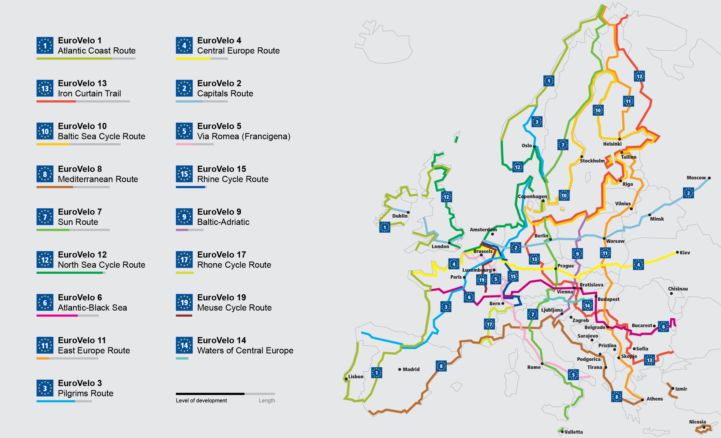First ever EuroVelo Route Development Report is published
The EuroVelo network now counts 17 routes covering a total of 95,959 km (85,328 km without counting overlapping sections) according to the first ever EuroVelo Route Development Report. This figure is even greater than the figures calculated in 2019, partly due to the opening of a new route, EuroVelo 14 – Waters of Central Europe.

Following its establishment with 12 European cycle routes in 1995, the EuroVelo network has grown considerably. Spanning 38 countries across Europe, EuroVelo is now the biggest cycle route network in the world! Since 2018, the ECF EuroVelo team has worked hard with our network of National EuroVelo Coordination Centres and Coordinators (NECC/Cs) to gather GPS tracks and official data of all EuroVelo routes – even those which are not fully realised yet – in order to build an accurate database of the levels of development across the network.
An overview of what each level of development means is available here. A yearly gathering of data will enable us to publish an annual edition of the EuroVelo Route Development Report, providing an analysis of network developments from year to year.
The network’s development status in 2021
This year’s data shows that 60% of the network (51,538 km) is either developed (21%), meaning the routes feature signage in line with the respective national standard and a website providing information to users; developed with EuroVelo signs (36%), meaning its signage incorporates EuroVelo route information panels too; or certified (3%), meaning the route has successfully undergone the certification process in line with the European Cyclists’ Federation’s (ECF) European Certification Standard. This corresponds to EuroVelo 15 – Rhine Cycle Route, the first certified EuroVelo route.

Another third of the network, about 33,000 km of cycle routes, still needs some improvements. Over a quarter of the network still remains under development, meaning that it is possible to follow the route either by signage or detailed information publicly available on the internet, but some sections may need further development. 12% of the network is at the planning stage. In this last category, the routes are not signposted and there is no detailed information publicly available on the internet. The proposed itinerary communicated shows the best option currently available but may also contain dangerous sections.
These parts are where the efforts of ECF and its partners all over Europe (including the NECC/Cs network) will be directed over the next ten years in order to improve the quality of the EuroVelo network – the main objective for this decade, according to the EuroVelo Strategy 2030. This is an ambitious objective, but it can be reached by working in common with the network of NECC/Cs across Europe and improving the routes via European projects and Long-Term Management Agreements!
Some key numbers for the EuroVelo network
What to take out of the EuroVelo Route Development Report 2021? Here are some key numbers that will help you get a good overview of the current network’s status!
- 23 countries with EuroVelo signs across Europe – that’s over 33,000 km of EuroVelo signage!
- 7 routes developed at 75% or more.
- EuroVelo 15 – Rhine Cycle Route is the most developed EuroVelo route, being also certified at 72%. It is followed by EuroVelo 17 – Rhone Cycle Route, EuroVelo 19 – Meuse Cycle Route and EuroVelo 14 – Waters of Central Europe, all developed and 100% signposted with EuroVelo signs. Then comes EuroVelo 12 – North Sea Cycle Route, with 97% of overall development.
- Switzerland is the country with the highest level of development of the EuroVelo network (100%), followed by France, the United Kingdom, Belgium and Austria. Details about the classification’s logic can be found in the report.
- EuroVelo 1 – Atlantic Coast Route is the longest EuroVelo route with 11,174 km, followed by EuroVelo 13 – Iron Curtain Trail (10,433 km) and EuroVelo 10 – Baltic Sea Cycle Route (9154 km).
- Germany is the country with the biggest portion of the network (10 routes - 9806 km), followed by France (10 routes - 8806 km) and the United Kingdom (4 routes - 6232 km).
Take a look at the EuroVelo Route Development Report of 2021 for more data, including classifications of all EuroVelo routes and countries according to their levels of development from a EuroVelo point of view. Please note that this report does not classify countries according to the overall quality of their cycling network, but only to the level of development of their EuroVelo routes. Meaning for instance that a country with a good cycling network but no EuroVelo signs may score less than in other classifications looking at cycling tourism in general.
Stay tuned for next year’s EuroVelo Route Development Report, which will highlight the improvements of the EuroVelo network that took place across Europe during the year.
Author: Florence Grégoire